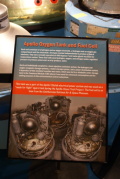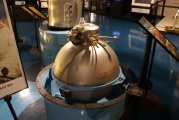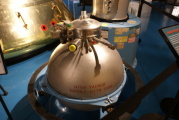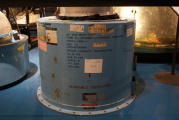Return to Stafford Air & Space Museum
Apollo Service Module Cryogenic Oxygen Tank
The museum displays a cryogenic (supercritical) oxygen tank. The Apollo Service Module carried two of these tanks and two cryogenic hydrogen tanks of a different design.
These oxygen tanks supplied oxygen to the environmental control system and to the SM's three fuel cells to generate power. These double-walled tanks were made of Inconel (a nickel-steel alloy) with an outer diameter of 26.55 inches; the inner tank was 25.06 inches in diameter. A vacuum was maintained between the tank walls, and the void between the tank walls contained insulation comprised of fiberglass, paper, and aluminum foil. The tank with accessories was 36.39 inches tall.
Each tank weight 79 ½ pounds empty and held a volume of 4.73 cubic feet or 320 pounds of oxygen in a supercritical (semi-liquid, semi-gas) state. 210 pounds of the oxygen was reserved for the fuel cells with the remaining 110 pounds used for environmental control.
The tank had a repressurization probe with two heaters and two fans to keep the tank pressurized and a capacitive probe to measure the amount of oxygen. Operating temperature of the tanks ranges from 300 degrees below zero to 80 above, although oxygen had to be maintained at 297 degrees below zero or colder to remain liquid.
A tank such as this famously exploded on the Apollo 13 mission, after Mission Control asked the crew to stir their O2 tanks. The Report of Apollo 13 Review Board, Final Report notes that the defective tank was the eighth Block II oxygen tank built, serial number 10024XTA0008, and that 28 Block I tanks had been previously built by the vendor, Beech Aircraft.
The tank on display is 10024XTA0051, presumably the forty-third tank built after that problematic tank.
After the Apollo 13 incident, a third oxygen tank was added to the Service Module, added in a different sector of the SM than the other two. A number of changes were made to the equipment installed inside the tank, including the removal of the fans from the tank interior and the removal of the thermostat switches from the oxygen tank heater circuits. Additionally, internal oxygen tank wiring was enclosed in stainless steel conduit instead of being coated with Teflon insulation. A third heater element was added, which allowed one, two, or three heaters to be turned at a time instead of the two heaters which were turned on or off together as in the previous incarnation of the tank. The tank's quantity gauge probe was changed from aluminum to stainless steel, and all soldered joints were replaced with brazed joints.
 dsc46592.jpg |
 dsc46594.jpg |
 dsc46596.jpg |
 dsc46598.jpg |
 dsc46600.jpg |
 dsc46602.jpg |
Return to Stafford Air & Space Museum